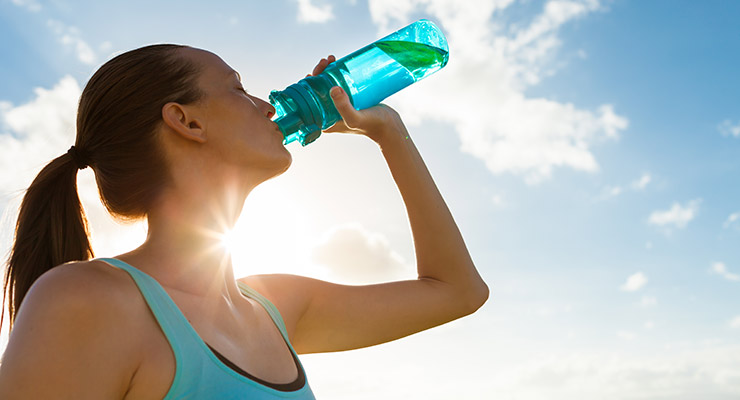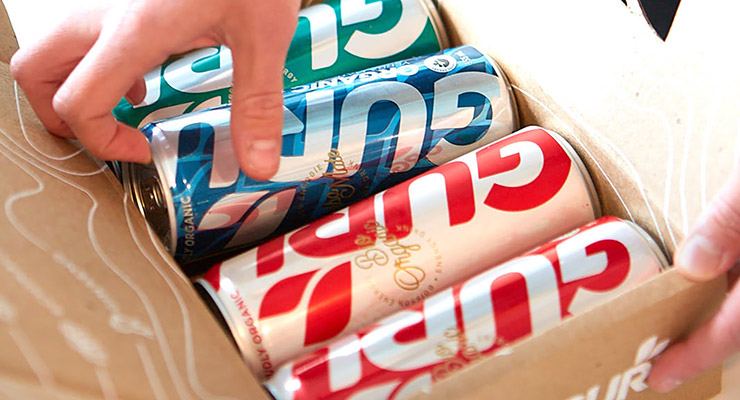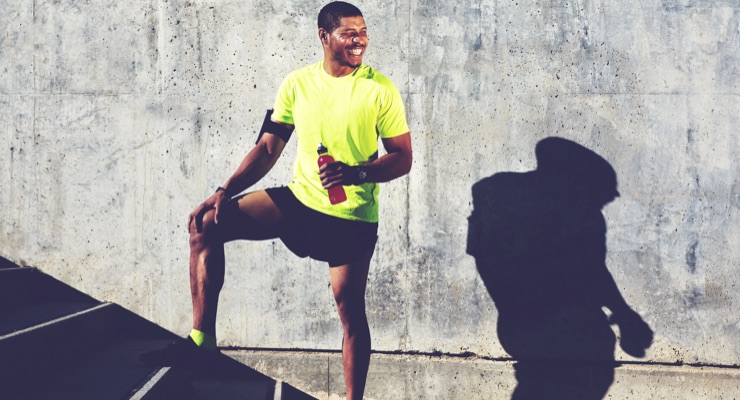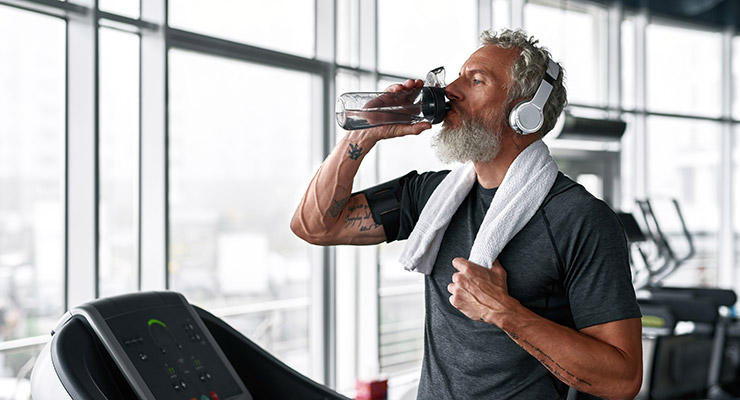Features
Top Sports Nutrition Trends That Reach Athletes and Everyday Consumers
Next generation energy drinks, hydration, and mobility have broad appeal and room for growth.

By: Sean Moloughney
Editor, Nutraceuticals World

From gamers and college kids who stayed out a little too late to the active adult who needs a midday pick-me-up after work and before their next pickleball match, energy drinks fill a niche for many consumers. Fueled by natural sources of caffeine and nootropics, newer energy drinks are standing out in a crowded and mature market.
“Energy and sports drinks are one of the categories that is growing the fastest among beverages,” according to Haleigh Resetar, corporate communications specialist at SPINS LLC.
The original sports drinks such as Gatorade and Powerade kept sodium to a reasonable limit to appeal to the professional athlete and person who dreams of being a sports star. However, newer sports drinks are very bold, incorporating 3-5 times the amount of sodium as first-generation sports drinks while marketing to consumers who aren’t actually losing tremendous amounts of electrolytes through sweat.
Another trend that is starting to pick up steam again is joint health. This subcategory appeals to a wide array of consumers throughout the lifespan, with more multi-functional products coming in a variety of formats, including bars, gummies, powders, and more.
Energy Drinks to Power Through
Energy drinks sales shot up 11.2% in multi-outlets (MULO) over a 52-week span ending on Oct. 2, 2022, and 29.1% for the previous two years, according to SPINS data. Total sales over the past year were $15.23 billion. This category is expected to continue to surge over the next several years. Although early generation energy drinks including Red Bull and Monster are still the category leaders, according to Statista, newer drinks are gaining ground by differentiating themselves from the competition.Newer introductions aren’t relying on stimulants alone. “Products hitting this category are promoting a new generation of energy drink that is lower in sugar, packed with functional ingredients, and free of artificial colors,” said Resetar. Popular functional ingredients include natural sources of caffeine including guarana and maca, nootropics to improve focus and concentration, and B vitamins.
SPINS highlighted Guru Energy and Rambler Energy in its Natural Products Expo East Trends to Watch. Canada’s top energy drink brand, Guru Energy, is expanding its presence in the U.S. Guru’s trademark is its clean, organic, non-GMO verified, plant-based ingredients. The company relies on natural sources of caffeine including green tea, matcha, and guarana and sweeteners monk fruit and stevia.
Guru isn’t after a hardcore audience. Instead, the company is marketing its energizing drinks as a solution for those at work, school, sports, or taking part in everyday life. The company reported a 35% increase in sales in July and August 2022 and a total $22.3 million for the first three quarters of 2022. Over the previous 18 months the company was the fastest growing energy brand in Canada, according to Nielsen data.

Rambler has 120 mg of caffeine from the ancient plant Yaupon, which is indigenous to the Southeastern U.S. Rambler also touts its plant-based ingredients and claims to deliver sustained energy while enhancing mental alertness thanks to Alpinia galanga.
Other ingredients that can lend a boost to cognitive function include L-theanine to enhance focus, and Bacopa monnieri, citicoline, or Alpha-GPC for memory.
Additionally, Nutrition 21’s Nitrosigine, a patented complex of bonded arginine silicate has been shown to improve immediate memory, according to a study published in Nutrients in 2021. Meanwhile, the company’s nooLVL, a patented complex of bonded arginine silicate with inositol, was found to improve mental acuity and focus and significantly improve accuracy in gamers, according to Katie Emerson, manager of scientific affairs at Nutrition21.
Resetar noted that more energy drink brands are targeting esport athletes, who are looking for ways to boost their cognition, improve reaction time, and prevent fatigue.
Overall, today’s consumer has a range of innovative functional energy drinks to improve alertness and focus without the jitters. “While there are many brands that consumers know and love, there are new contenders in this category that are pushing the envelope by including new attributes,” said Resetar. Nootropics, plant-based sources of caffeine, and clean sugar substitutes help drinks stand out in a crowded space.
Hydration and Electrolytes Hit Mainstream
Hydration drinks have morphed from athlete-inspired messaging for “serious” athletes to all-day hydration for everyone. As a result, over the past 52 weeks ending Oct. 2, 2022, the hydration and electrolyte subcategory ran full steam ahead with a healthy 113.4% growth to tally $314.26 million compared to $147.23 million over the previous year. In comparison, the performance nutrition category grew 41.6%.“We are seeing greater interest in products offering hydration, apart from a late-night pick me up,” said Resetar. “Proper hydration can have benefits including increased immunity, better sleep quality, and improved cognition—all of which are health concerns that many consumers are struggling with or have an interest in.”
Drinking enough fluid each day is the most important factor for avoiding dehydration. For many people this is a challenge; dehydration might reach a 2-3% decrease in body weight before some people feel thirsty.1 A body water loss of just 1-2% can impair concentration, short-term memory, and cognitive performance while increasing reaction time, moodiness, and anxiety.2,3 For athletes and active competitors, a 2% decrease in body weight due to sweat fluid losses can impact athletic performance, especially in the heat.

Beyond Fluids
Though fluid is the most important consideration for staying hydrated, many people don’t drink enough each day. Sports dietitians help athletes stay hydrated with electrolyte-rich sports drinks. Electrolytes— particularly sodium, the top electrolyte lost in sweat—help the body retain more of the fluid consumed (less fluid consumed is lost through urine).4 Electrolytes are also essential for muscle contraction and nerve conduction.Liquid I.V. became trendy with its powdered hydration drinks and its suggestive name. Liquid I.V. capitalized on an underserved niche in the hydration market: the everyday consumer. In its most recent fun-inspired campaign, “Fuel Your Play,” Liquid I.V. suggests its powdered electrolyte drink mixes provide a beneficial hydration boost to people engaging in all forms of play including everyday activities such as hiking, sitting by the pool, and skateboarding.
Liquid I.V. is based on WHO guidelines for an Oral Rehydration Solution (ORS) for the treatment of short-term illness triggered by infection and inflammation of the digestive system.5 If someone has acute diarrhea or they are throwing up, one of the most serious consequences is dehydration. This is what makes Pedialyte a mainstay among clinicians; it is an ORS used to counteract dehydration in hospitals and critical care settings. Hospital patients who can’t drink enough are given an IV delivering fluid, sodium, potassium, and sometimes glucose. Liquid I.V.’s name suggests rapid rehydration versus actually needing to get an IV.
Given the other number of oral rehydration solutions on the market today, Liquid I.V. didn’t create anything new.6 However, the company took a concept that has been around for years, added great branding, and marketed it to an entirely different, and much larger, segment of the population.
The success of Liquid I.V. has led to additional SKUs with added functional ingredients including one for energy and focus with L-theanine and coffee extract, as well as an immune support SKU with vitamin C, zinc, and yeast-derived beta-glucan.
Although Liquid I.V. started a massive trend, other companies have been riding its coattails. In particular, Biolyte and Trace Minerals also put out mass-market hydration drinks and mixes for regular consumers to hydrate without an IV.
Biolyte calls its drinks “the IV in a bottle.” The company started off marketing its drink as a medical aid, hangover cure, and sports drink. Biolyte has reportedly doubled in profit every year and it is on track to make $25 million in 2022.7
Because regular consumers don’t need the amount of carbohydrates or calories an active athlete does, Biolyte added erythritol to cut calories in half compared to a typical sports drink. Biolyte also ramped up the sodium to compete with earlier generation ORS and added vitamins as well as ginger to soothe an upset stomach.
Trace Minerals Hydration I.V. Electrolyte Drink Paks claim to provide 20x the hydration of water for those who work out, are on the go, outside, or interested in wellbeing. Like Biolyte, the company added B vitamins and a sizable amount of sodium in a mix that contains half of the calories as a typical sports drink. The Trace Minerals products also come in some unique flavors, including raspberry lemonade and strawberry coconut.
Hydration solutions for the everyday consumer are popular. Important ingredients include sugar (dextrose, glucose, a mix of sugars, or clean-label sugar substitutes) sodium, chloride, and potassium. Adding targeted ingredients for immune health, cognitive function, or stomach upset can make a product stand out in a crowded marketplace.

Maintaining Mobility
From young, active football players and runners to aging Baby Boomers, joint health is an important category throughout the lifespan. In fact, approximately 30% of adults report some type of joint pain.8 “Joint pain is a severe limitation to both performance and general activities of daily living,” noted Michael Ormsbee, director of the Institute of Sports Sciences & Medicine at Florida State University.In 2020, when people were restless after being shut inside for months, increased activity led to a greater focus on joint health. As a result, the joint health category shot up that year. “That growth was unsustainable and bound to go down, which is why joint health has a more modest growth of 3.5% over the past year,” explained Resetar.
Though glucosamine and chondroitin sulfate still lead the joint health supplement category, collagen is everywhere, in many formats—from gummies to coffee creamers—while hyaluronic acid, curcumin, Boswellia serrata AKBA, and other options can also help alleviate achy joints.
Collagen has several things going for it. First, it tackles multiple purposes—skin, joint, tendon and ligament health. “Collagen peptides are also a single ‘clear label’ ingredient and natural protein source, tapping into two current megatrends,” said Liz Clarke, technical marketing manager at Nitta Gelatin.
A key challenge in the collagen market is providing an alternative for vegan consumers as nothing compares to the amino acid makeup of collagen.
A 2018 meta-analysis found collagen, when taken regularly, can significantly reduce joint pain.9 Additionally, both collagen hydrolysates and undenatured collagen (regardless of the source or molecular weight) help reduce cartilage destruction or promote cartilage repair. Most of the research suggests collagen supplements are a relevant treatment option for those with osteoarthritis. However, very few studies looked at collagen vs. a placebo and most studies were of short duration.
It isn’t clear exactly how collagen works, though studies have found that chains of amino acids (peptides) from collagen hydrolysate supplements gather in cartilage tissue just hours after the supplements were taken. The research to date suggests collagen supplements may work via one or more of these mechanisms: stimulate cartilage cells to synthesize collagen, inhibit the death of healthy cartilage cells, and the peptides in collagen supplements may serve as the building blocks for cartilage.
Collagen is also used widely by athletes as both a preventive measure for joint and tendon health when taken with a source of vitamin C about 45-60 minutes prior to physical therapy or training, and also as part of a treatment plan post-injury.
While known for being injected into joints to potentially relieve pain, hyaluronic acid can also be taken orally through a supplement or as a functional ingredient in foods. Hyaluronic acid is important for maintenance of healthy synovial fluid. Studies show hyaluronic acid may help improve some symptoms of osteoarthritis.10
Curcumin can help decrease inflammation and protect the body from free radical damage. Curcumin also appears to be an effective ingredient for osteoarthritis.11 Curcumin is the most active compound found in turmeric.
“Unfortunately, pure turmeric contains only about 3% curcumin and many commercially available turmeric powders contain only about 0.5-1.5%. As a result, most curcumin dietary supplement products on the market use concentrated turmeric that is standardized to contain 95% curcumin,” said Nena Dockery, scientific affairs manager at ESM Technologies/Stratum Nutrition.
Not all curcumin ingredients on the market necessarily function the same in the body, as some are plant-derived and some are made synthetically. It’s important to choose an ingredient with adequate research substantiation. Additionally, curcumin is very poorly absorbed and therefore the best curcumin ingredients are specifically made to be more bioavailable.12
Boswellia serrata, which comes from trees grown in the dry mountainous regions of India, Northern Africa, and Middle East, helps decrease inflammatory markers and attenuate cartilage breakdown.13 Additionally, a meta-analysis including seven trials found Boswellia serrata may help reduce pain and stiffness associated with osteoarthritis if taken for at least 4 weeks.14 Boswellia serrata has also been shown to increase walking distance and increased knee flexion in patients with osteoarthritis.
Some research suggests a combination of ingredients may be best. For instance, a native type II collagen combined with Boswellia serrata helped decrease joint discomfort in 5 days.15 Additionally, a combination of chondroitin sulfate, glucosamine hydrochloride, and hyaluronic acid with native type II collagen led to better results than the same combination without native type II collagen.16
Although the joint health category saw a massive and unsustainable increase in sales in 2020, it is beginning to pick up steam again. Collagen continues to show versatility both in functionality and format, fitting into beauty-from-within and joint health products while also appearing in various powders, foods, and beverages.
Additional solutions for joint health include hyaluronic acid, curcumin, and Boswellia serrata. All show promise for helping alleviate symptoms of joint pain while keeping consumers active.
About the Author: Marie Spano, MS, RD, CSCS, CSSD, is one of the country’s leading sports nutritionists and a nutrition communications specialist. She is the lead author of Nutrition for Sport, Exercise and Health and has appeared on CNN as well as NBC, ABC, Fox, and CBS affiliates. Find her on Twitter and Instagram @mariespano.
References
- Institute of Medicine. (2005). Dietary Reference Intakes for Water, Potassium, Sodium, Chloride, and Sulfate. Washington, DC: The National Academies Press. https://doi.org/10.17226/10925
- Ganio, M. et al. (2011). Mild dehydration impairs cognitive performance and mood of men. British Journal of Nutrition, 106(10), 1535-1543. https://doi.org/10.1017/S0007114511002005
- Armstrong, L. et al. (2012). Mild Dehydration Affects Mood in Healthy Young Women, The Journal of Nutrition, Volume 142, Issue 2, February 2012, Pages 382–388. https://doi.org/10.3945/jn.111.142000
- Rakova. N. et al. (2017). Increased salt consumption induces body water conservation and decreases fluid intake. J Clin Invest. 2017 May 1;127(5):1932-1943. https://doi.org/10.1172/JCI88530
- Ladinsky, M. et al. (2000). The World Health Organization Oral Rehydration Solution in US Pediatric Practice: A Randomized Trial to Evaluate Parent Satisfaction. Arch Pediatr Adolesc Med. 2000;154(7):700-705. https://doi.org/10.1001/archpedi.154.7.700
- Polin, R. et al. (2021). MD, Pediatric Secrets, Chapter 7 (Gastroenterology), 213-261. https://www.sciencedirect.com/topics/nursing-and-health-professions/oral-rehydration-solution
- Lagorio-Chafkin, C. (2022.) Biolyte Started as a Secret Project. Now It’s on Track for $25 Million in Annual Revenue This Year. Inc. https://www.inc.com/christine-lagorio-chafkin/bioltye-jesslyn-rollins-ceo-comedian.html
- National Health Interview Survey. (2006). Centers for Disease Control and Prevention. https://www.cdc.gov/mmwr/preview/mmwrhtml/mm5717a9.htm
- García-Coronado, J. et al. (2019). Effect of collagen supplementation on osteoarthritis symptoms: a meta-analysis of randomized placebo-controlled trials. International Orthopaedics (SICOT) 43, 531–538. https://doi.org/10.1007/s00264-018-4211-5
- Oe, M. et al. (2016). Oral hyaluronan relieves knee pain: a review. Nutr J. 2016 Jan 27;15:11. https://doi.org/10.1186/s12937-016-0128-2
- Hewlings, S. et al. (2017). Curcumin: A Review of Its Effects on Human Health. Foods. 2017 Oct 22;6(10):92. https://doi.org/10.3390/foods6100092
- Jamwal, R. (2018). Bioavailable curcumin formulations: A review of pharmacokinetic studies in healthy volunteers. J Integr Med. 2018 Nov;16(6):367-374. https://doi.org/10.1016/j.joim.2018.07.001
- Blain, E. et al. (2010). Boswellia frereana (frankincense) suppresses cytokine-induced matrix metalloproteinase expression and production of pro-inflammatory molecules in articular cartilage. Phytother Res. 2010 Jun;24(6):905-12. https://doi.org/10.1002/ptr.3055
- Yu, G. et al. (2020). Effectiveness of Boswellia and Boswellia extract for osteoarthritis patients: a systematic review and meta-analysis. BMC Complement Med Ther. 2020 Jul 17;20(1):225. https://doi.org/10.1186/s12906-020-02985-6
- Jain, A. et al. (2021). AflaB2® and osteoarthritis: a multicentric, observational, post-marketing surveillance study in Indian patients suffering from knee osteoarthritis. International Journal of Research in Orthopaedics. 2021 Jan;7(1):110-115. https://dx.doi.org/10.18203/issn.2455-4510.IntJResOrthop20205570
- Sifre, V. et al. (2020). Macroscopic and histologic improvements in joint cartilage, subchondral bone and synovial membrane with glycosaminoglycans and native type ii collagen in a rabbit model of osteoarthritis. Osteoarthritis and Cartilage. Vol 28, Supplement 1. S206, April 01, 2020. https://doi.org/10.1016/j.joca.2020.02.335


